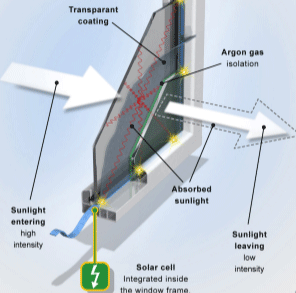PowerWindow, a clean energy-producing window
Solar panels are cost intensive, have limitations with respect to where they can be integrated into the build environment and, as they are non-transparent, they cannot be used as windows. The PowerWindow converts sunlight into clean energy, using a technique we call ‘BI-CPV’ (building-integrated concentrated photovoltaics). Compared to the failed technology of the ‘80s and ‘90s based on organic dye‘s, our patent-pending inorganic materials have broad-band sunlight absorption and no self- absorption losses. This state-of- the-art technology turns objects through which we have looked through for ages, our windows, into energy source.
PowerWindow is a clean energyproducing tinted window that generates electricity by combining three existing technologies into one. We coat our window with a unique luminescent material. We transport light through the glass to the window edges in the same way as in an optical fiber. Furthermore, at the edges of the window, integrated in the window frames, strip-shaped CIGS PV solar cells convert the light into electricity.


Production
PowerWindow applies a luminescent coating on newly produced windows using a technique called magnetron sputtering. This technique is also used to make tinted windows for cars and offices. Because production is similar to existing techniques and the tinting of the glass is similar, PowerWindow can directly compete with regular office windows, especially because the product has the huge advantage of being able to convert sunlight into clean energy. After the glass is coated, we install the CIGS PV solar cells in the form of strips at the edges of the window in the window frame. These solar cells consist of mainstream thin-film PV technology and can therefore be easily customized and produced to fit many types and shapes of windows.
Future Fit
PowerWindow is a building-integrated technology that enables you to use construction space in a more efficient and environment-friendly way. It contributes to set targets of the European Union towards energy neutral cities. Furthermore, it is a solution that has no geographical limitations. Therefore, PowerWindow fits perfectly in our vision of modern society, infrastructure and global planning. At some point in time we will see electric cars driving on the street when looking through our clean energy-converting windows.
Conclusion
We believe that the PowerWindow is a no-compromise cost-effective sustainable energy solution due to three main reasons. First of all, you do not lose the functionality of your windows and the aesthetics of your building is not affected. Furthermore, you need 100 times less solar cells per surface area, since only strips on the edges of the window are required (instead of the entire surface area). Finally, you are not restricted by the roof surface area to produce clean electricity.
Advantages
- Building-integratable.
- Contributes to EU targets towards energy-neutral cities.
- Thin-film PV technology is easily customized and produced to fit many types and shapes of windows.
- Cost effective because less solar cells are required per surface area and because PowerWindow does not add to the cost of a building as it replaces windows. In other words, it is not an extra shell to a building as solar panels on a roof or facades are.